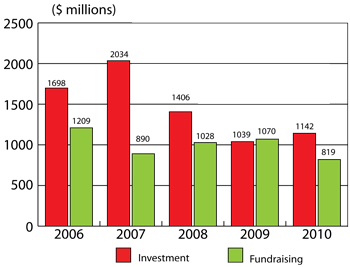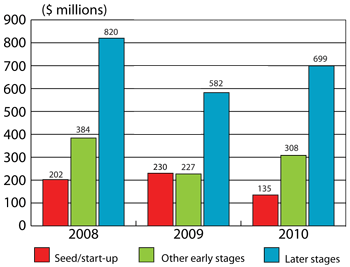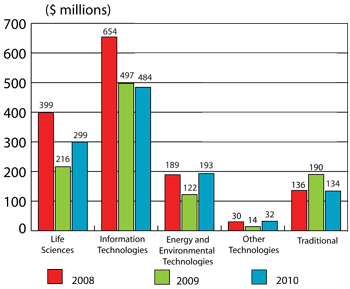PDF Version
Venture Capital Monitor - Q4 2010
152 KB, 7 pages
Canadian high growth innovative small and medium-sized enterprises (SMEs) that commercialize research depend to a large extent on the venture capital (VC) industry for funding. Therefore, a strong VC industry is important for the growth of this segment of SMEs. The goal of this series is to provide current information about the VC industry in Canada. To this end, the series will track trends in investment activity, report on topical VC-related research and look at key technology clusters where VC investment is taking place.
Introduction
This year-end issue discusses venture capital (VC) investment and fundraising activity through January to December 2010, which despite slow fourth quarter activity, saw the first per-annum increase in investment levels since 2007.
Investment and fundraising
Increase in year-over-year deal sizes
Despite slow fourth quarter activity during which $241 million was invested in 115 deals, VC investment experienced a moderate recovery in 2010.
Growth was buoyed by a strong second quarter during which $335 million was invested. A total of $1.14 billion (407 deals) was invested over 2010, approximately a 10 percent increase over the $1.04 billion invested during 2009 (Table 1). Despite this, VC activity in Canada continues to remain significantly below pre-recession levels, 21 percent short of the $1.40 billion invested in 2008 (Figure 1).
| FY 2009 | FY 2010 | % Change | |
|---|---|---|---|
| ($ billions) | |||
| Source: Thomson Reuters Canada 2011. | |||
| Investment | 1.04 | 1.14 | 10 |
| Fundraising | 1.1 | 0.82 | −26 |
Figure 1: VC Investment and Fundraising by year, 2006 to 2010

Source: Thomson Reuters Canada 2011.
In contrast to the improvement in investment levels VC fundraising reached historic lows for the second year in a row as only $819 million was raised in 2010 (Table 1). This is 26 percent less than 2009 and is the lowest amount raised in the Canadian market over the past 16 years. This was primarily the product of a significant drop in major closings of new private independent funds. As a result, the primary sources of new fundraising in 2010 were labour sponsored venture capital corporations (LSVCC) and provincial government.
Deal size
Increase in year-over-year deal sizes
In 2010, 407 firms were backed with VC, a 7.8 percent increase over the 2009 total (Figure 2). This is comparable to 2008 levels during which 435 firms were backed with VC. Deal sizes did not move up considerably as they averaged $2.8 million in 2010 compared to $2.7 million in 2009. Notably, since 2008 the proportion of deals worth less than $1 million has steadily increased, while financings between $1 million and $4.9 million have experienced a precipitous decline.
Figure 2: Distribution of VC investment by deal size, 2008 to 2010

Source: Thomson Reuters Canada 2011.
Stage of development
Decrease in seed/start-up investment, but increase in large later stage investments
Investments continued to be concentrated in later-stage deals (61 percent of all value), increasing both in terms of deals and value during 2010. The combined value of financing in other early stages and later stages in 2009 was over $1 billion, a 24 percent increase relative to 2009. However, nearly $100 million less was captured by seed/start-up firms over the same period (Figure 3). There were only two new seed investments over the Q4 2010 compared to 11 over the same period in 2009 and an average of 12 per quarter over the past two years.
Figure 3: VC investment by stage of development, 2008 to 2010

Source: Thomson Reuters Canada 2011.
There was a greater number of later stage financings in 2010 than anytime over the past five years (246 deals), but these deals were also smaller on average ($2.8 million) than anytime over this period. In particular, 117 new investments in later stage companies worth $214 million were made in 2010. Over the same period in 2008, $240 million was invested in 76 deals (Table 2). Foreign funds continued to play an important, albeit slightly diminishing role in late-stage investments. Despite placing more than 60 percent of its total investment into late-stage funds, foreign-based investments only represented 26 percent of all late-stage financing, compared to 33 percent in 2009 and 34 percent in 2008.
New versus follow-on investments
New investments drop in early-stage investments but increase in later stage investments
There were 172 first-time VC deals in 2010, 24 more than in 2009 and the first year-over-year increase in three years. These new deals were worth $359 million, which indicates that while there were more first-time VC deals in 2010 they were of smaller value than new deals in 2008 and 2009. First-time deals at the seed and start-up stages of development were particularly low during 2010, with 15 less than 2009 and almost half the amount of deals as in 2008. In contrast, at the later stages of development first-time VC deals experienced a significant increase compared to previous years (Table 2).
| Total Investments | 2008 | 2009 | 2010 | |
|---|---|---|---|---|
| Source: Thomson Reuters Canada 2011. | ||||
| New | Seed/ start-up | 10 | 16 | 11 |
| Other early stages | 6 | 3 | 6 | |
| Later stage | 30 | 23 | 23 | |
| All | 46 | 42 | 40 | |
| Follow-on | Seed/ start-up | 9 | 19 | 12 |
| Other early stages | 19 | 28 | 21 | |
| Later stage | 34 | 42 | 37 | |
| All | 62 | 89 | 70 | |
| Total | All | 435 | 378 | 407 |
Type of investor
Increase among private independent and foreign funds, retail funds decline
In 2010, both private independent and foreign funds experienced increased activity following the downturn in 2009. LSVCCs and retail funds continued to experience decreased activity with a decline of $15 million year-over-year. The amount invested by foreign funds in 2010 continued to recover since 2008, as Canadian companies attracted $331 million in foreign financing, 6 percent more than as in 2009 (Figure 4). As a result, crossborder activity accounted for 29 percent of total dollars invested, which approximates the traditional market share.
Figure 4: Distribution of VC investment by type of investor, 2008 to 2010

Source: Thomson Reuters Canada 2011.
Fundraising
Lowest per-annum level of Canadian fundraising in 16 years
In contrast with an improved investment climate, Canadian VC fundraising activity was particularly weak in 2010. Only $819 million of new capital was committed to domestic funds, down 24 percent from $1.1 billion committed the year before (Table 1). This represents the lowest per-annum level of fundraising achieved in the Canadian market in 16 years of reporting.
A key factor in the year-over-year drop was a comparative shortage of major private independent fund closings. Most notably, during the Q3 2010, there were no private fund closings. As a result, private funds brought $350 million of new supply into the market last year, 41 percent below 2009 levels. The greatest contributors to new VC supply over the year were government and retail funds.
Regional distribution
Increase in VC investment in British Columbia, Ontario and Alberta
In 2010, the value of VC invested in three of Canada's four most populous provinces (Ontario, BC and Alberta) increased. Quebec led Canada in the amount of deals completed (190) (Table 3), but Ontario attracted the greatest value of VC ($424 million) (Figure 5). The largest increase in investments occurred in Ontario, where companies received 43 percent more in 2010 than in 2009; so Ontario captured 37 percent of Canadian disbursements in Q3 2010. As a result of strong growth in investment in British Columbia's ICT and energy/environmental sectors, British Columbian firms attracted $55 million more in VC investments in 2010 than 2009 (Figure 5).
| Province | 2009 | 2010 | % Change |
|---|---|---|---|
| Source: Thomson Reuters Canada 2011. | |||
| British Columbia | 48 | 51 | 6 |
| Alberta | 21 | 22 | 5 |
| Saskatchewan | 10 | 5 | -50 |
| Manitoba | 6 | 8 | 33 |
| Ontario | 103 | 118 | 15 |
| Quebec | 172 | 190 | 10 |
| New Brunswick | 6 | 7 | 17 |
| Nova Scotia | 9 | 6 | 0 |
| Prince Edward Island | 0 | 0 | 0 |
| Newfoundland | 3 | 0 | -100 |
| Territories | 0 | 0 | N/A |
Figure 5: Regional distribution of VC investment in Canada, 2008 to 2010

Source: Thomson Reuters Canada 2011.
Sector distribution
Increase in life sciences and energy/ environmental technologies; small decline in information andcommunication technology
Over the year, information and communication technology (ICT) firms continued to attract the most financing ($484 million or 42 percent of all financing) (Figure 6). However, this is less than 2008 and 2009 levels as the growth in the total VC investment value in 2010 is attributable to increased life sciences and energy/ environmental technology activity. Compared to 2009 life science firms attracted an additional $83 million and energy/ environmental technology firms attracted an additional $71 million (Figure 6).
Figure 6: VC investment by industry sector, 2008 to 2010

Source: Thomson Reuters Canada 2011.
The $193 million attracted by energy/environmental technologies is the most ever invested into the sector and was primarily driven by financings into clean tech companies. This is a result of several very large deals. In particular Enerkem Technologies Inc. closed a $53.8 million deal in January.
Government activities
Business Development Bank of Canada activities
During Q4 2010, the Business Development Bank of Canada (BDC) made VC commitments totalling $4.7 million in five companies (Table 4). These financings were worth a total of $21.8 million including contributions by co-investors. This activity was in addition to any investment in private independent funds made by the BDC during the quarter.
| BDC | Co-investors | Total | Number of deals | |
|---|---|---|---|---|
| ($ million) | ||||
| Source: Business Development Bank of Canada 2011. | ||||
| Seed and start-up | 2.4 | 7.6 | 10.0 | 3 |
| Development | 2.3 | 9.5 | 11.8 | 2 |
| Later stage | 0 | 0 | 0 | 0 |
| Total | 4.7 | 17.1 | 21.8 | 5 |
New Centres of Excellence for Commercialization and Research
On December 6, 2010 the Minister of Industry, Tony Clement, announced $61.1 million in funding for five new Centres of Excellence for Commercialization and Research (CECR). The CECR program is an innovative model of the ability to bridge the gap between innovation and commercialization and a cornerstone of Canada's science and technology (S&T) strategy.
The centres are private-sector led and provide important resources to researchers such as facilities, testing services, refinement of business development strategies and industry connections. These activities promote investment readiness amongst start-up firms and can improve demand for venture capital.
The following centres will divide $61.1 million in funding:
- The MiQro Innovation Collaborative Centre (Bromont, Quebec),
- The Centre for Commercialization of Regenerative Medicine (Toronto, Ontario),
- The Centre for Imaging Technology Commercialization and Research (London, Ontario),
- Leading Operational Observations and Knowledge for the North (St. John's, Newfoundland and Labrador), and
- The Wavefront Wireless Commercialization Centre (Vancouver, British Columbia)
Notes
This publication is part of a series prepared by the Small Business Branch. The branch analyses the financial marketplace and how trends in this market impact small businesses' access to financing. Current research is focused on high-growth firms, the aspects of both Canada's VC and general business environment that affect the success of these firms, and the key players in the risk-capital market (for example, VC firms and angels).
To be added to the distribution list for this quarterly publication, please make your request at the Subscribe to Publications page.
For questions related to its content, please email SBB-DGPE.
